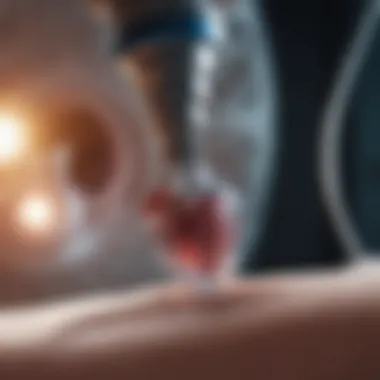Heart Valve Replacement Survival Rates Explained


Research Overview
In recent years, heart valve replacement has emerged as a critical procedure in cardiac surgery, demonstrating significant advancements in patient outcomes. The examination of survival rates following these surgeries offers crucial insights into the effectiveness of treatments and the various factors affecting recovery and longevity. Understanding these rates is essential for patients, healthcare providers, and researchers alike.
Methodological Approaches
The analysis of heart valve replacement survival rates often involves a blend of retrospective and prospective studies. Researchers typically collect data from patient records and clinical trials, allowing them to assess the outcomes over defined periods. For instance, many studies evaluate patients over five to ten years post-surgery to archive long-term survival data. Key metrics frequently examined include:
- Overall survival rates: How many patients survive at one, five, and ten years after surgery.
- Event-free survival: The rate at which patients do not experience significant events related to heart function.
- Quality of life: Assessment of how patients feel post-surgery in terms of health and activity levels.
These metrics provide a robust framework for comparing different surgical approaches and valve types.
Significance and Implications
Understanding survival rates from heart valve replacement procedures carries substantial implications. For patients, knowing these rates can influence decisions about treatment options. For healthcare providers, these statistics help in evaluating the effectiveness of specific surgical techniques. Moreover, they guide future research efforts aimed at improving the procedure. Recognizing the demographics that contribute to varying outcomes can also lead to more personalized patient care.
Current Trends in Science
The burgeoning field of cardiac surgery has seen remarkable innovations in techniques and tools, impacting survival rates and patient outcomes. Staying abreast of these trends is essential for anyone involved in cardiac health.
Innovative Techniques and Tools
Among the most notable advancements are minimally invasive surgical approaches for valve replacement. Techniques such as Transcatheter Aortic Valve Replacement (TAVR) have transformed how surgeons perform these surgeries. The benefits include:
- Reduced recovery time: Patients often spend less time in the hospital.
- Less postoperative pain: These techniques generally involve smaller incisions.
- Lower risk of complications: With less invasive methods, the chance of infection or other complications is diminished.
Moreover, improved imaging technologies, like 3D echocardiography, have enhanced pre-operative planning and intraoperative guidance.
Interdisciplinary Connections
Cardiac surgery does not exist in a vacuum. Researchers are increasingly collaborating across disciplines to enhance the care of patients undergoing heart valve replacement. For example, insights from fields such as bioengineering and data science have started shaping surgical techniques and postoperative care strategies. The development of patient-specific models for surgery planning is one example of this interdisciplinary approach.
Preface to Heart Valve Replacement
Heart valve replacement is a critical procedure that directly affects patient quality of life and longevity. Understanding the implications of this surgery, particularly the survival rates, can aid patients and healthcare professionals in making informed decisions. Knowledge of the performance of various heart valves and advancements in surgical techniques is crucial. This section will delve into the definition and overview of heart valve replacement, as well as highlight the importance of maintaining healthy heart valves.
Definition and Overview
Heart valve replacement occurs when a diseased or damaged heart valve is surgically replaced with an artificial valve. The procedure is essential for addressing issues like stenosis or regurgitation, which can lead to significant complications if left untreated. Mechanical valves, made from durable materials like titanium and carbon, offer longevity but require lifelong anticoagulation management. Conversely, biological valves are crafted from animal tissues and tend to integrate more naturally into the body but may have a shorter lifespan than their mechanical counterparts. Each type of valve carries different risks and benefits, which are important for patients to understand before undergoing surgery.
Importance of Heart Valve Health
Healthy heart valves play a crucial role in ensuring effective blood flow through the heart chambers. They open and close with each heartbeat, directing blood to the lungs and the rest of the body. Compromised valves can lead to heart failure, stroke, and other serious health issues. Regular check-ups and monitoring of valve function are vital for preventing complications. For patients with existing heart conditions, pursuing heart valve replacement can significantly enhance their overall health and survival rates. Understanding these health dynamics empowers individuals and encourages proactive healthcare engagement.
Types of Heart Valve Replacement
Understanding the different types of heart valve replacements is crucial for anyone exploring the landscape of cardiac surgery. This section details the two main categories: mechanical valves and biological valves. Each type has distinct characteristics, advantages, and potential drawbacks that must be considered in the context of patient needs and outcomes.
Mechanical Valves
Mechanical valves are designed to be durable and long-lasting, often made from materials like titanium or carbon. Their primary benefit is their longevity, typically lasting several decades, which can be appealing for younger patients. Here are a few important points to consider:
- Durability: Mechanical valves can endure significant wear and tear, meaning they can last a lifetime if properly managed.
- Anticoagulation Requirement: Patients with mechanical valves will need to take anticoagulants, such as warfarin, to prevent blood clots. This requirement can present challenges in managing their health, as it requires regular blood testing and careful monitoring.
- Surgical Technique: Mechanical valves often require open-heart surgery, which carries inherent risks and longer recovery times compared to some other options.
Patients must weigh these factors carefully, given that lifestyle choices may change after receiving a mechanical valve.
Biological Valves
Biological valves, or tissue valves, are made from human or animal tissue, typically porcine or bovine. These valves often appeal to older patients due to their less invasive management post-surgery. Consider these factors:


- Less Need for Anticoagulants: Biological valves usually require less lengthy anticoagulation therapy. This can simplify post-operative care dramatically.
- Shorter Lifespan: The major trade-off is their durability. Biological valves might need to be replaced every 10 to 15 years, especially in younger patients. This potential for multiple surgeries can add to overall healthcare costs and emotional stresses over a lifetime.
- Natural Function: Many patients prefer biological valves for aesthetic or philosophical reasons, as they mimic the function of natural heart valves more closely than mechanical options.
Comparison of Valve Types
When discussing the types of heart valve replacements, it's helpful to identify the key differences and similarities. The choice between mechanical and biological valves hinges on several considerations:
- Lifespan: While mechanical valves can last several decades, biological valves may require replacement sooner.
- Anticoagulation Therapy: Mechanical valves necessitate long-term anticoagulation, while biological valves often do not.
- Frequency of Replacement: Understanding the possible need for further surgery can heavily influence a patient's decision and future health management.
> Quote
"Choosing the right valve is a balancing act between lifespan, management requirements, and overall health objectives of the patient."
Factors Affecting Survival Rates
The survival rates following heart valve replacement surgeries can significantly alter based on a variety of factors. Understanding these factors is crucial for both patients and healthcare providers. They can inform decisions, tailor post-operative care, and ultimately enhance outcomes. The key elements include patient demographics, pre-existing health conditions, and the type of heart valve used in the procedure. Each of these aspects plays a distinct role in influencing recovery and long-term health after surgery.
Patient Demographics
Demographics such as age, gender, and ethnicity influence survival rates after heart valve replacement. Generally, younger patients tend to have better outcomes than elderly individuals. This could be attributed to a combination of factors: younger patients typically have fewer comorbid conditions and more resilient cardiac function. Furthermore, sex may also contribute. Some studies indicate that women may have higher early mortality rates post-surgery compared to men. Ethnic background, while less studied, could also impact healthcare access and associated risk factors like obesity and hypertension. Therefore, these demographic characteristics should be carefully evaluated when assessing risks and post-operative expectations.
Pre-existing Health Conditions
Patients with pre-existing health conditions are more prone to complications following heart valve replacement. Conditions such as diabetes, hypertension, and renal disease significantly diminish survival rates. Diabetes affects wound healing and increases the risk of infections, while hypertension can lead to cardiovascular complications during recovery. Renal disease complicates medication metabolism and can affect fluid balance, placing extra strain on the heart. A comprehensive assessment of these health issues is essential pre-surgery for optimizing both surgical tactics and rehabilitation approaches.
Type of Heart Valve Used
The type of heart valve selected for replacement plays an important role in outcomes and overall survival rates. Mechanically-designed valves often provide durability and require less frequent replacement, but they come with a higher risk of thromboembolic events, necessitating lifelong anticoagulation therapy. On the other hand, biological valves tend to have a lower risk of clot formation but may not last as long as mechanical valves. Their suitability also varies based on patient age and lifestyle factors. For example, younger patients may prefer mechanical valves due to longevity, while older patients may choose biological valves to avoid the complications of long-term anticoagulation.
"Decisions regarding valve type should involve a thorough discussion between clinicians and patients about trade-offs, personal preferences, and lifestyle impacts."
Understanding these factors enables better preoperative planning and personalized postoperative care, ultimately aiming for improved survival rates.
Statistics and Research Findings
The study of survival rates post-heart valve replacement is crucial in understanding the efficacy of surgical interventions. With increasing numbers of patients undergoing these procedures, statistics provide a foundation for assessing both quality of care and outcomes. Analyzing these figures can inform clinical practices, influence patient decision-making, and shape healthcare policies. Furthermore, contextualizing survival rates with relevant demographics and health conditions enhances the depth of understanding regarding patient experiences and recovery.
General Survival Rates
General survival rates for heart valve replacement procedures have shown significant improvement over the years. Studies suggest that approximately 85% to 90% of patients survive at least five years after receiving a valve replacement. These figures can vary based on patient demographics, such as age and overall health, as well as the type of valve used. For example, patients under the age of 65 tend to exhibit higher survival rates compared to older individuals. Additionally, other factors such as the surgical technique employed and the presence of comorbidities also play a role in shaping these statistics.
Long-term Survival Data
Long-term survival data provides valuable insights into the ongoing health of patients following heart valve replacement. Research indicates that survival rates can reach 70% to 75% over a 10 to 15 year period, depending largely on patient-related factors and the type of valve implanted. Notably, data illuminates the differences between mechanical and biological valves regarding durability and patient outcomes. For instance, while mechanical valves may offer longer-lasting solutions, they often require lifelong anticoagulation therapy, impacting the long-term health of patients. Conversely, biological valves typically do not necessitate such rigorous treatment but might need replacement sooner. Understanding these dynamics is critical for both healthcare providers and patients when weighing options.
Recent Studies and Their Implications
Recent studies in heart valve replacement surgery continue to evolve, offering fresh perspectives and guidelines. Research from major cardiovascular organizations illustrates trends and innovations that directly influence patient outcomes. For example, developments in minimally invasive surgical techniques have correlated with lower complication rates and improved recovery times. Furthermore, ongoing studies focusing on patient quality of life post-surgery emphasize the importance of patient-centered care practices. These studies advocate for comprehensive rehabilitation programs after surgery to assist recovery and enhance long-term survival.
"Survival rates are not merely numbers but indicators of patient well-being and effective treatment methodologies."
Advancements in Surgical Techniques
Advancements in surgical techniques for heart valve replacement have crucially improved patient outcomes. The evolution of these methods has reduced recovery times, minimized hospital stays, and enhanced overall success rates. Surgeons now have access to more precise tools and methods, which ultimately lead to better patient care.
Minimally Invasive Surgery
Minimally invasive surgery is one of the most significant developments in heart valve replacement. This technique involves smaller incisions compared to traditional open-heart surgery. Patients benefit from reduced trauma, resulting in lower levels of pain and quicker recovery times. Studies have shown that patients undergoing this type of surgery also experience shorter hospital stays, which can lead to decreased healthcare costs.
The benefits of minimally invasive surgery include:
- Less postoperative pain
- Reduced risk of infection
- Faster return to daily activities


Despite these advantages, not all patients qualify for minimally invasive procedures. The suitability largely depends on the specific heart condition and the patient's overall health.
Robotic-Assisted Procedures
Robotic-assisted procedures represent another significant advancement in surgical techniques. This method employs robotic systems to aid surgeons in performing precise operations. These systems allow for greater dexterity and visualization during surgery. Surgeons can make finer movements that would be impossible through traditional methods.
The implications of using robotic assistance include:
- Enhanced accuracy and precision
- Greater visualization of the surgical field
- Reduced blood loss
As robotic technology continues to advance, more heart valve replacements may become feasible through this technique. Yet, like minimally invasive surgery, candidates must be evaluated to determine the best surgical approach.
The Role of Imaging Technologies
Imaging technologies play an essential role in the success of heart valve replacement surgeries. Innovations such as 3D imaging and echocardiography provide vital information to surgeons. These tools facilitate pre-surgical planning, allowing for a tailored approach to each patient's needs.
Accurate imaging is vital for:
- Identifying the specific type of valve to replace
- Assessing the overall heart function
- Creating a detailed surgical plan
With reliable imaging, surgeons can anticipate any potential complications before they arise. This preparedness can lead to improved outcomes and higher survival rates.
"The integration of advanced imaging techniques revolutionizes the way surgeons approach heart valve surgery, enhancing both safety and effectiveness."
Postoperative Care and Recovery
Postoperative care and recovery are critical components in the journey following heart valve replacement. This period directly influences a patient's prognosis and quality of life. Understanding the nuances of postoperative care can significantly impact healing and long-term survival rates. This section will detail essential aspects of care that patients should anticipate and the benefits derived from adhering to medical advice during recovery.
Immediate Post-Surgery Care
Immediate postoperative care focuses on the first few days after surgery. In this phase, patients are closely monitored in the intensive care unit or a recovery unit. Key elements include:
- Vital Sign Monitoring: Healthcare providers check blood pressure, heart rate, and oxygen levels regularly.
- Pain Management: Effective pain relief is essential for comfort and encourages mobility. Intravenous medications may be administered initially.
- Fluid Balance: Patients will typically receive fluids through IV to stay hydrated and balanced.
- Wound Care: The surgical site must be monitored for signs of infection or complications. Proper management is crucial.
These initial hours and days are vital to safeguard against complications such as bleeding, infection, or arrhythmias. The medical team plays an integral role in ensuring smooth recovery.
Long-term Recovery Expectations
Long-term recovery following heart valve replacement varies among individuals. It generally spans weeks to months and involves many factors, including age, overall health, and adherence to rehabilitation.
Common expectations during this phase include:
- Fatigue: Patients may feel tired, which is a common occurrence as the body heals. Gradual return to normal activities is recommended.
- Monitoring of Symptoms: Individuals must learn to recognize concerning symptoms, such as difficulty breathing or chest pain, which warrant immediate medical attention.
- Follow-up Appointments: Regular check-ups ensure valves are functioning well, and adaptations in medications can be made if necessary.
Understanding these expectations allows patients to prepare mentally and physically. Some may find emotional support beneficial as they navigate their recovery period.
Rehabilitation Programs
Rehabilitation programs play a vital role in a successful recovery from heart valve replacement. These structured programs are designed to enhance physical function and improve overall quality of life after surgery.
Key aspects include:
- Cardiac Rehabilitation: Often initiated within a few weeks post-surgery, this program focuses on supervised exercise, education about heart health, and lifestyle modifications. A shift towards a heart-healthy diet becomes a cornerstone.
- Psychosocial Support: Managing anxiety and depression is essential. Many centers offer counseling to aid emotional well-being throughout the recovery.
- Patient Education: Understanding the recovery process and necessary lifestyle changes, like reducing salt intake, abstaining from smoking, and regular exercise, is crucial for long-term success.
Participating in a rehabilitation program allows individuals to regain strength and confidence while reducing the risk of complications in the future.
Conclusion: The journey from heart valve replacement surgery through postoperative care and recovery is significant in shaping survival outcomes. Proper care, supportive rehabilitation, and awareness foster a better recovery experience. Through the structured approach of immediate care, realistic long-term expectations, and comprehensive rehabilitation programs, patients can navigate this critical phase more effectively.
Potential Risks and Complications


Heart valve replacement is a complex procedure that offers significant benefits for patients with heart valve diseases. However, like any surgical intervention, it carries potential risks and complications that can impact patient survival and quality of life. Understanding these complications is crucial for both patients and healthcare providers, as it highlights the importance of informed decision-making and thorough preoperative assessments.
Common Complications Post-Surgery
Following heart valve replacement surgery, several complications may arise. These complications can range from mild to severe and may require additional interventions. Common issues include:
- Infection: Surgical site infections can develop, posing serious health risks. Prompt management is essential.
- Blood Clots: Patients are at risk for thrombosis, particularly with mechanical valves. Anticoagulation therapy is often necessary.
- Bleeding: Hemorrhage can occur during or after surgery, sometimes requiring transfusions.
- Valve Dysfunction: In some cases, the new valve may not function properly, leading to further interventions.
- Arrhythmias: Irregular heartbeats can arise post-surgery due to surgical trauma or other factors.
Each of these complications can have significant implications for recovery and ultimately influence survival rates. The risk of complications necessitates careful monitoring and ongoing communication between patients and their healthcare teams.
Long-term Health Concerns
In the context of heart valve replacement, long-term health concerns are of paramount importance. Even after successful surgeries, patients must be vigilant for potential issues that can affect their longevity and quality of life:
- Recurrent Valve Issues: Some patients may experience wear or degeneration of the replacement valve over time, necessitating further surgical procedures.
- Organ Health: Patients may face risks of organ dysfunction, especially if the heart has significant underlying issues prior to surgery.
- Lifestyle Changes: Post-surgery recovery can lead to changes in lifestyle, which can be both positive and negative. Patients may need to adapt their activity levels and diets.
- Mental Health: The psychological impact of surgery can linger. Anxiety and depression are common concerns that require attention.
Research indicates that managing these long-term concerns effectively can significantly enhance survival rates post-surgery. Continuous follow-up and proactive interventions can mitigate risks and promote better outcomes for patients.
"Awareness of what lies ahead can empower patients to engage with their healthcare proactively, ultimately leading to improved long-term success after heart valve replacement."
Patient Perspectives
Understanding patient perspectives is essential in the discourse surrounding heart valve replacement survival rates. This section aims to delve into two key aspects: the experiences of patients before surgery and their insights after undergoing the procedure. By emphasizing these perspectives, we can identify emotional support needs, inform healthcare professionals about patient concerns, and ultimately improve outcomes.
Experiences Prior to Surgery
Before heart valve replacement, patients often face a multitude of emotions ranging from anxiety to resignation. Knowing that they have a condition requiring such a significant surgical intervention can be overwhelming.
Many patients describe their life before surgery as characterized by physical limitations and troubling symptoms. Tiredness, shortness of breath, and heart palpitations are some common complaints. Interaction with medical personnel may also contribute to their anxiety. Concerns about surgery risks, recovery, and long-term outcomes often dominate their thoughts.
Engagement with support groups or forums can offer a sense of community for many, where shared experiences serve as reassurance. Patients may conduct extensive research, exploring articles and studies related to heart valve replacement, only to realize that every case is unique.
Important considerations include:
- Understanding risks: A clear presentation of the surgery's risks can help alleviate fears.
- Education about procedures: Knowledge about the types of heart valves, surgical techniques, and expected recovery can demystify the process.
- Emotional preparation: Recognizing the psychological impact of pre-surgery anxiety is crucial for both patients and caretakers.
Insights on Post-Surgery Life
Life after heart valve replacement can be drastically different from what patients experienced prior to surgery. Many patients report feeling an immediate sense of relief as symptoms diminish. The journey, however, is not devoid of challenges. Awareness of these factors helps form a comprehensive understanding of long-term survival rates.
Most individuals have varying recovery experiences based on their health status before the operation and the type of valve they received. Adjustments to lifestyle often become necessary, including changes in diet and increased physical activity. Patients may need ongoing monitoring to manage their heart health effectively.
Feedback from patients reveals several important points post-surgery:
- Quality of life improvement: Many experience noticeable enhancements in their daily lives, with reduced physical limitations.
- Continued support systems: The role of family and support groups is vital. Sharing experiences with others who have undergone similar procedures can foster resilience.
- Psychological effects: Coping with emotional challenges such as changes in identity and fear of recurrence should be addressed.
The integration of patient insights into future research can help healthcare providers understand the intricacies of recovery and tailor support accordingly.
"Understanding others' journeys can help ease the fear of the unknown. It provides a form of comfort to know you’re not alone in this struggle."
Retrieving insights from patient experiences not only highlights what may be improved in healthcare practices but also pins a real human element to the statistics and data surrounding heart valve replacements.
End
In this article, we explored the complex landscape of heart valve replacement survival rates, an essential subject for patients and healthcare providers alike. The significance of understanding these survival rates cannot be overstated. It not only informs clinical decision-making but also enhances patient awareness regarding their own post-surgical journey.
Summary of Key Findings
Recent findings indicate that survival rates improve with advancements in surgical techniques and personalized postoperative care. Key factors such as patient demographics, existing health conditions, and the type of valve utilized play critical roles in these outcomes. Specific data reveal that mechanical valves often offer longer longevity, while biological valves present advantages in terms of fewer complications. Treatment tailored to individual patient needs has become increasingly important. The majority of data shows that patients can expect favorable outcomes following surgery, especially when comprehensive evaluation and management strategies are employed.
Future Directions in Research
Looking ahead, further research is essential in several areas:
- Long-term Effectiveness: More studies are needed to assess the durability of both mechanical and biological valves over time.
- Technology Innovations: Continued development of less invasive surgical procedures and improved imaging technologies can enhance success rates.
- Personalized Medicine: Exploring how genetics and specific health factors can influence valve replacement outcomes offers potential breakthroughs.
- Patient Education and Support: Understanding the role of patient perspectives and experiences can lead to better engagement and preparedness for postoperative life.
Future studies should aim to provide comprehensive insights that support patients throughout their journey, leading to improved survival rates and overall quality of life.



